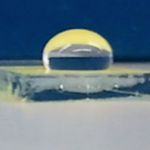As we know the most of living beings of the earth consume energy from the plant materials. Because, the plants are the major chemical energy generator from sun light and the storage master for the chemical energy on earth. So, plants are the awesome creation of the nature. When we consider us. We are use electronic technology for most of our day to day work. As all living beings connect with plants. We are now also connect with electronics. Have you ever think to connect these plant and electronic technology. Sometime your answer may be no. but scientists in Linköping University in Sweden had been thought to connect plants and electronic technology and was able to create Electronic plants with the natural plants. Yes it’s an awesome news to hear. Let’s see about it.
 |
| Electronic Plants | Image Credit : Berggren |
In natural plants all chemical signals, nutrients and other metabolic materials transfer through the xylem and phloem tissues. As well as plants use connected cell walls to communication of within the cells. All these functions are occur in a slower time scale when comparing with animals. Becourse of this small time scale, Its difficult to botanist for study about the plants. If it make to connected these chemical process of plants with the electric signals botanist can control and interfacing with chemical pathways in plants. This opportunity could gave the way to photosynthesis-based fuel cells, sensors and growth regulators, and devices that modulate the internal functions of plants.
How they Created the Electronic Plants?
Professor Berggren and his team in Linköping University was able to introduce special conductive polymer into the rose stems. This special conductive polymer known as the PEDOT-S and synthesized by Dr. Roger Gabriession. The result of this polymer was the the xylem channels in rose became into conducting wires. The interesting thing is these conductive xylems also able to transfer water and nutrients as a normal xylem tissue. Their first conductive xylem wires was 10 cm long. They used a electrolyte and made a electrochemical transistor and that transistor was able to convert ionic signals in plants into electronic output. Using this electrochemical transistors Dr. Eleni Stavrinidou was demonstrated a digital logic gate function.
In this team Dr. Eliot Gomez infused another PEDOT conductive polymer variant in to plant leaves using the vacuum infiltration method and formed pixels of electrochemical cells partitioned by the veins. After that he applied a voltage into polymer and allowed to interact with ions in plant leaf. The result was the changes of the colour of PEDOT according to the ion concentration in leaf.
Electronic plants are the results of the organic electronics and the plant science. These plants may use for the application for energy, agriculture and other environmental application. Actually this is a new item for the electronic world. The research team of Laboratory of Organic Electronics (LOE), LIU. under the leadership of Professor Magnus Berggren have published a article about this electronic plants on the journal Science Advances. According to these innovations We can expect electrically controlled crop plants in fields within few years..



